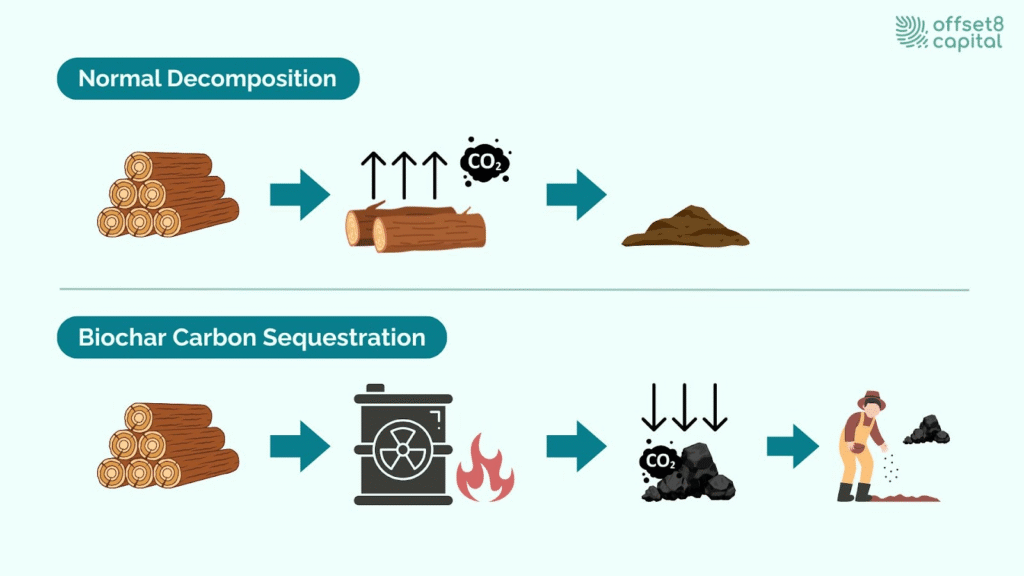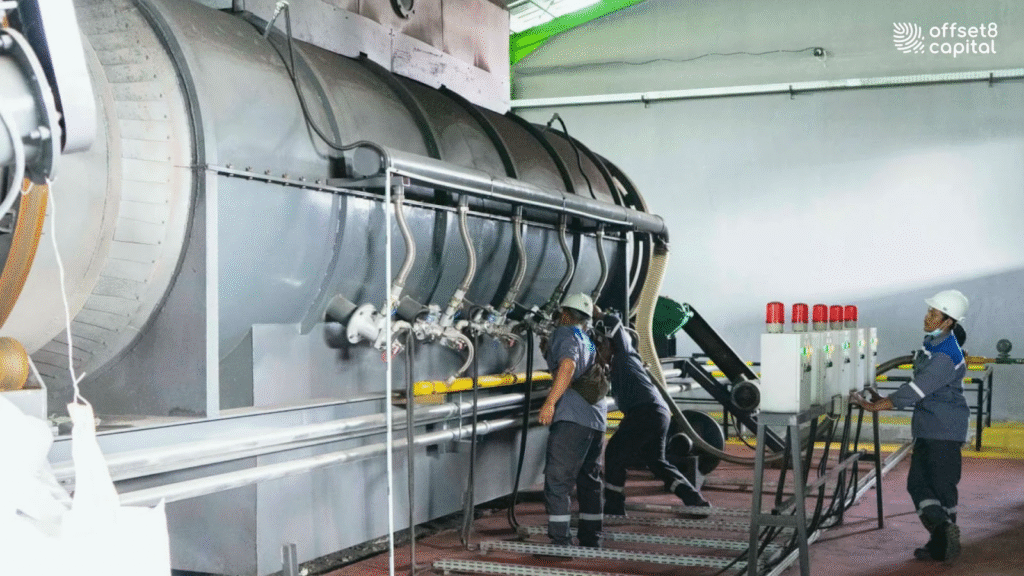
Did you know that as wood, bamboo, plants, and livestock manure decompose, they release greenhouse gases such as carbon dioxide and methane into the atmosphere? To address these widespread sources of emissions, the carbon-rich material known as biochar has attracted growing attention worldwide as a carbon capture solution.In carbon markets, biochar credits, sometimes referred to as biochar carbon credits, are increasingly recognized as a removal-based solution. What is biochar carbon removal and how does it address these emissions? This article explores what biochar is, its origins, mechanisms and benefits, its role in carbon credits markets, what biochar is used for across various industries, and its potential for the future.

Biochar is a carbon-rich, black solid produced by heating biomass such as wood chips, agricultural residues, and livestock manure under oxygen-limited or nearly oxygen-free conditions (pyrolysis). Its chemical and physical properties vary widely depending on the feedstock, pyrolysis equipment, and conditions of cooling and storage, so it is not a single uniform material. Originating as a form of “black carbon,” biochar is designed to convert organic carbon into a more stable form for long-term sequestration. Unlike traditional charcoal used for fuel, biochar is specifically engineered for biochar carbon removal and soil amendment applications.
In early biomass pyrolysis research, the main focus was on producing bio-oil as a renewable fuel, and biochar was regarded merely as a by-product to be burned for process heat. More recently, however, attention has shifted to biochar itself, with increasing emphasis on maximizing carbon stability rather than surface area or combustion properties.
Importantly, the pyrolysis process still generates co-products such as bio-oil and synthesis gas, making biochar production not only a pathway for carbon removal but also part of an integrated bioenergy solution that supports renewable energy objectives.
The main purpose of biochar is to store carbon for the long term, and today’s use of it is inspired by practices that began thousands of years ago in the Amazon. Archaeological and soil studies show that Indigenous peoples of the Amazon Basin used a method now called “slash and char.” They partially burned plant material and mixed it into the soil, creating the remarkably fertile black earth known as Terra Preta de Indio, or Amazonian Dark Earths.
These dark soils occur across Brazil and other parts of South America and were probably created between 500 and 2,500 years ago. Early researchers once thought they came from volcanic ash, but most scientists now agree that they are the result of intentional or incidental soil management by Indigenous communities. Compared with the surrounding Oxisols, Terra Preta contains exceptionally high amounts of stable organic carbon, reaching up to 150 grams per kilogram of soil. The enriched layers can be 40 centimeters to more than a meter deep, and these carbon stocks have remained intact for centuries. The long-lasting “black carbon” within the soil, which is chemically similar to modern biochar, shows how charred plant matter can lock away atmospheric carbon for millennia.
Today, scientists, farmers, and climate policy makers are applying the same idea on purpose. Modern biochar is made by heating plant residues and other biomass in low-oxygen conditions, a process called pyrolysis, and then adding it to soil. This improves fertility and prevents nutrients from washing away, the same benefits observed in Terra Preta. Governments and voluntary carbon markets now view biochar as a practical tool for climate mitigation because placing it in fields instead of burning it keeps carbon out of the atmosphere while also boosting crop yields and soil health. By understanding how biochar is used in modern applications, we can see how twenty-first century biochar projects are reviving and refining a technique that Indigenous Amazonians pioneered many centuries ago.
To understand biochar's value, it's essential to compare technological carbon storage with natural biological carbon fixation processes. Biological carbon fixation occurs when plants capture atmospheric CO₂ through photosynthesis and convert it into organic compounds like cellulose, lignin, and sugars. This natural process temporarily removes carbon from the atmosphere and stores it in plant biomass.
However, biological carbon fixation has inherent limitations. When plants die and decompose, soil microorganisms break down the organic matter, releasing most of the stored carbon back to the atmosphere as CO₂ and methane within decades. This creates a continuous carbon cycle where atmospheric carbon is temporarily captured but eventually returned.
Biochar technology intervenes in this biological carbon fixation cycle by converting plant biomass into a stable form before decomposition occurs. Rather than allowing natural biological carbon fixation to run its complete cycle, pyrolysis locks the carbon in a form that resists microbial breakdown for centuries. This represents a fundamental shift from short-term biological fixation to long-term technological storage, with biochar capable of maintaining carbon for hundreds to even thousands of years.
What is biochar's carbon removal mechanism? How does biochar sequester carbon compared to natural processes? Biochar reduces atmospheric carbon dioxide (CO₂) by locking the carbon contained in organic matter into a stable charcoal-like form. Under normal conditions, biomass such as wood and crop residues is gradually decomposed by microorganisms, and the carbon is released back into the atmosphere. In contrast, when this biomass undergoes pyrolysis under oxygen-limited conditions, much of its carbon remains in solid form as biochar instead of escaping as gas.

Fig 1: Natural Decomposition vs. Biochar Carbon Sequestration
The biochar produced in this way is highly resistant to chemical decomposition. When applied to soil, it can store carbon in a stable state for hundreds to even thousands of years. In addition, biochar is highly porous and has a large surface area, allowing it to act like a sponge that retains water and nutrients in the soil. These properties improve soil moisture retention and aeration and help prevent fertilizer nutrients from being washed away by rainfall. As a result, plant root development and crop yields increase, and the long-term health of the soil is enhanced.
Research has also shown that soils amended with biochar emit less methane (CH₄) and nitrous oxide (N₂O), two potent greenhouse gases. This effect is thought to result from changes in microbial activity that improve both nitrogen and carbon cycling in the soil. Through these combined benefits of long-term carbon sequestration, improved soil quality, and reduced greenhouse gas emissions, biochar offers a highly promising strategy for mitigating climate change.
What is biochar used for across different sectors? Biochar applications span multiple industries:
Agricultural Applications:
Environmental Applications:
Industrial Applications:
Biochar carbon credits represent verified atmospheric carbon removal, making them highly valuable in voluntary carbon markets. Biochar permanently removes carbon dioxide from the atmosphere and is recognized as a carbon-removal credit. Leading certification frameworks include Verra’s VM0044 methodology, Puro.Earth, and Gold Standard, each requiring rigorous verification of the amount of carbon removed per metric ton. Because of its high permanence and transparency, biochar credits generally trade at higher prices than conventional avoidance-type credits and are increasingly favored in corporate decarbonization strategies.In Japan’s J-Credit scheme, biochar credits currently command prices roughly 6.7 to 20 times higher than standard J-Credits. Understanding biochar carbon credits price dynamics is crucial for investors. Japan’s Joint Crediting Mechanism (JCM) is also showing strong interest: in 2025 the AEM-METI Economic and Industrial Cooperation Committee (AMEICC) conducted a study on developing a dedicated JCM methodology for biochar, highlighting the growing attention to this removal pathway.

Biochar is widely recognized as an effective biochar carbon capture approach and continues to gain global attention. Around the world, numerous organizations are advancing biochar research, standards, and market development. Notable examples include Asosiaci Biochar in Indonesia, the Japan Biochar Association, the International Biochar Initiative (IBI) and the US Biochar Initiative in the United States, the European Biochar Certificate (EBC) in Switzerland, and Biochar Europe in Germany.
| Organization Name | Country | Description |
| Asosiasi Biochar Indonesia | Indonesia | The Asosiasi Biochar Indonesia was founded in 2012 by a group of committed environmentalists. It promotes biochar as a sustainable solution for agricultural waste management, soil health improvement, and climate change mitigation. |
| Japan Biochar Association | Japan | Japan Biochar Association (JBA) promotes carbon sequestration, soil improvement, and environmental restoration through the use of biochar, advancing greenhouse gas reduction and sustainable regional development. |
| International Biochar Initiatives | USA | The International Biochar Initiative (IBI) works globally to scale biochar solutions by fostering collaboration, education, and best practices to accelerate climate action and build resilient ecosystems and economies. |
| US Biochar Initiative | USA | The US Biochar Initiative (USBI) promotes the production and use of biochar across agricultural, industrial, and infrastructure sectors in North America to reduce biomass waste, grow the economy, and mitigate climate change. |
| European Biochar Certificate (EBC) | Switzerland | The European Biochar Certificate (EBC) provides a science-based quality and safety standard to ensure sustainable, low-impact biochar production and use, giving producers a recognized certification and users reliable assurance of environmental and health safeguards across Europe. |
| Biochar Europe | Germany | Biochar Europe is a network that advances the European biochar sector by collaborating with industry, scientists, and policymakers to drive supportive policies, develop science-based standards, foster research, and connect stakeholders to promote responsible, circular biochar applications. |
Table 1: Global Biochar Organizations
The international biochar organizations highlighted above are helping drive this rapid market expansion through their work in research, standard-setting, and market development.
Beyond their environmental value, biochar also offers significant business opportunities through carbon credits and related market mechanisms. For example, Sawa Ecosolutions in Indonesia develops biochar-based carbon credits that deliver measurable climate benefits while creating local employment and stimulating regional economies.
Such projects demonstrate biochar’s strong potential as a high-integrity carbon-removal asset capable of advancing both climate action and sustainable economic growth.
Biochar is a distinctive carbon-removal solution that locks atmospheric carbon in a stable form for centuries while enriching soils and ecosystems. Backed by internationally recognized certification frameworks, it provides investors and companies with high-integrity credits that carry exceptional market value. By delivering enduring environmental and economic benefits, biochar is emerging as a pivotal element of global net-zero and decarbonization strategies.
Disclaimer
This commentary is for informational purposes only and should not be considered financial, investment, or regulatory advice. Offset8 Capital Limited is regulated by the ADGM FSRA (FSP No. 220178). No assurances or guarantees are made regarding its accuracy or completeness. Views expressed are our own and subject to change
Biochar is produced by heating biomass in low-oxygen conditions (pyrolysis), which converts much of the organic carbon into a stable, charcoal-like form. When added to soil, this carbon can remain locked away for hundreds to thousands of years instead of returning to the atmosphere as CO₂ or methane.
Biochar’s porous structure improves soil moisture retention, aeration, and nutrient availability, leading to stronger plant growth and higher yields. Research also shows that soils amended with biochar emit less methane (CH₄) and nitrous oxide (N₂O), two potent greenhouse gases.
Yes. Biochar carbon credits are recognized as a carbon-removal credit under leading standards such as Verra’s VM0044 and Puro.Earth. Because of its permanence and transparency, biochar credits often trade at higher prices than conventional avoidance credits, creating attractive opportunities for investors and companies pursuing net-zero goals.